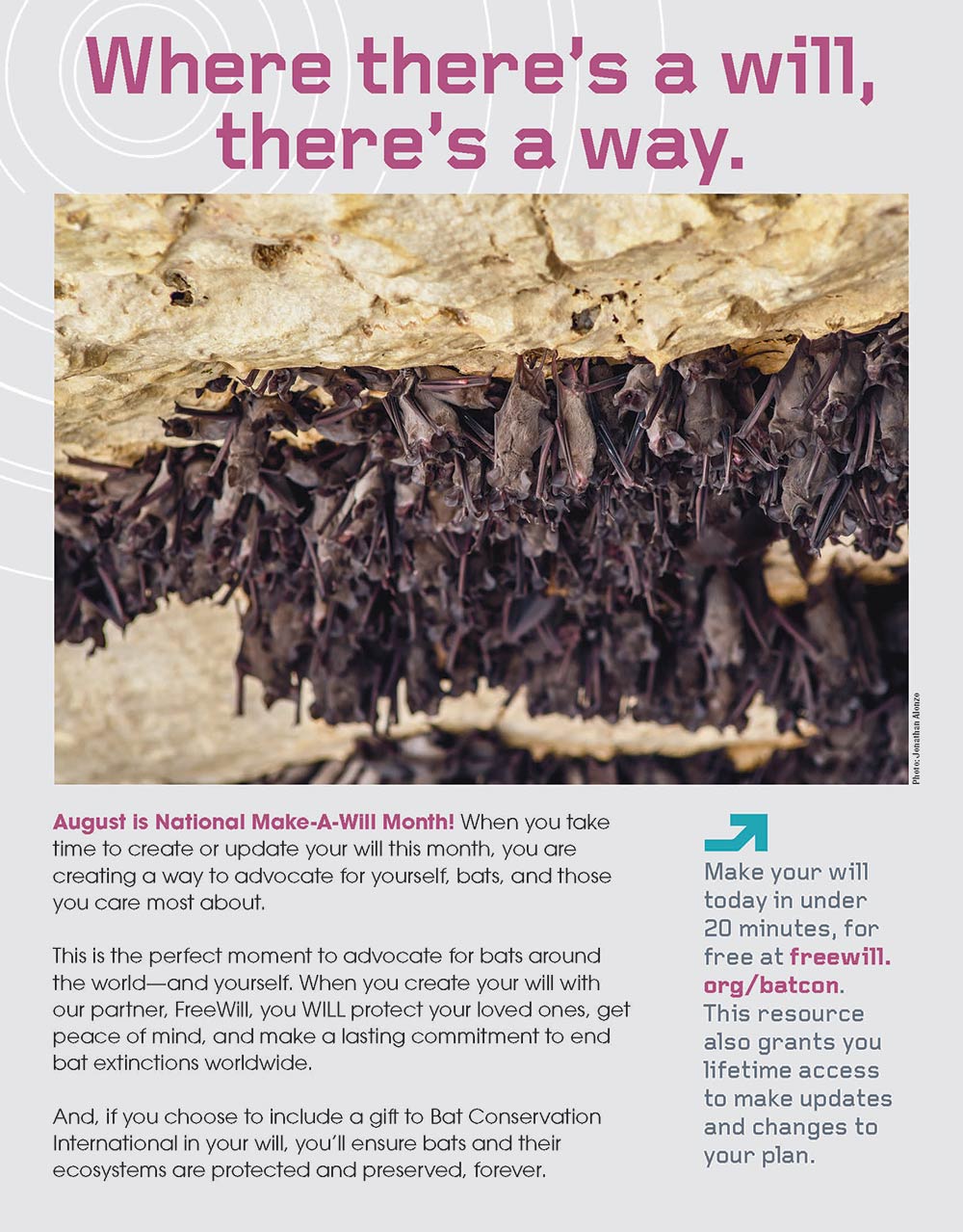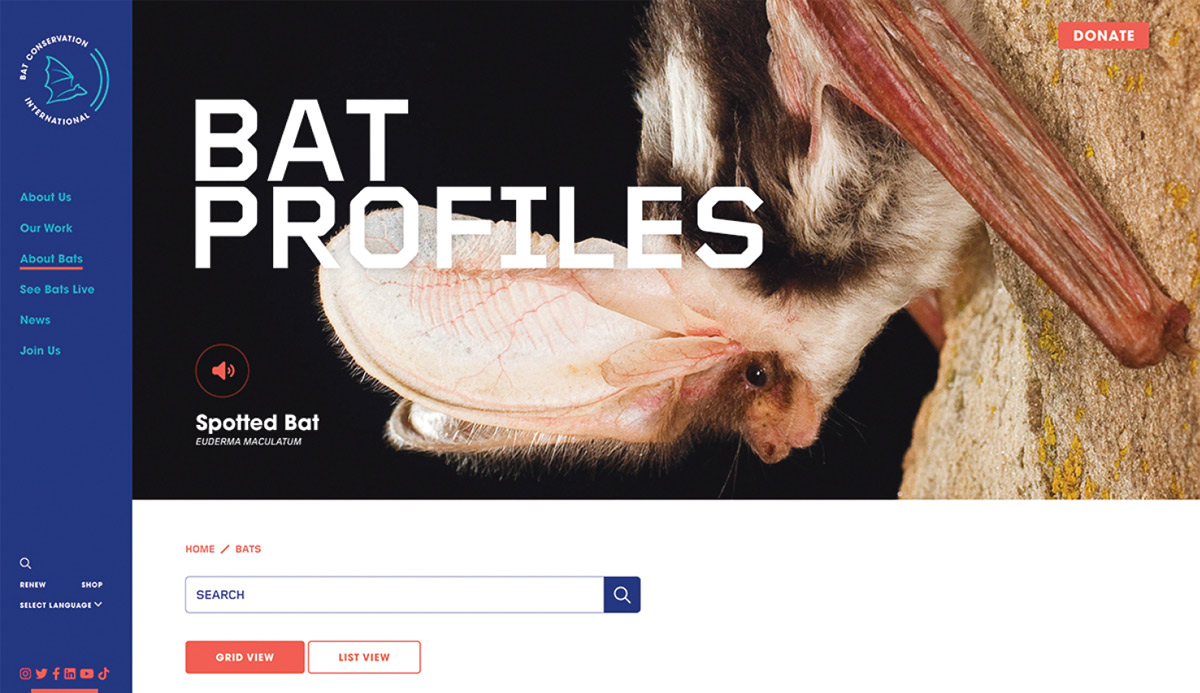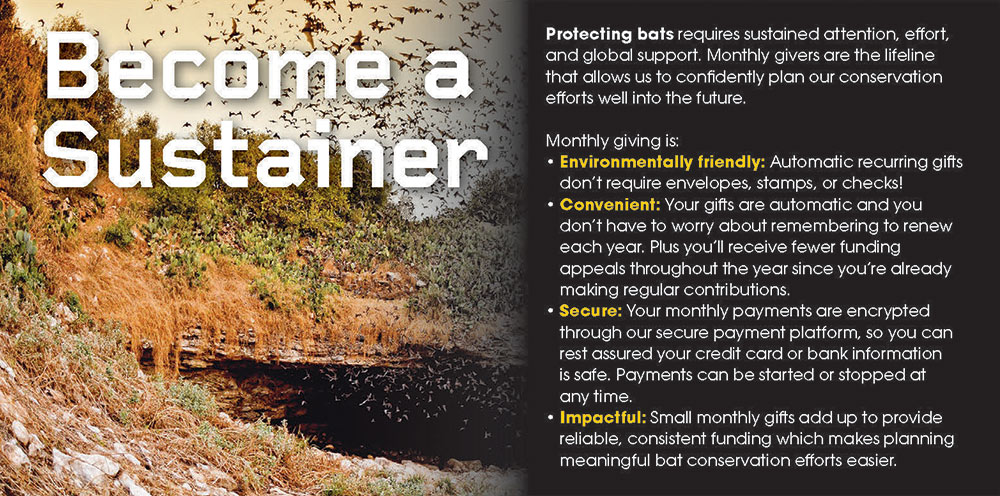Bat Conservation International Bats Magazine


Inside this Issue

Features
Departments
news & updates
- Bracken Cave sets a world record
- Protecting Mexican long-nosed bats
- Agave restoration
- Bat facts
- Virtual bat experiences
- Predator-proof fencing in Jamaica
- Tagging Critically Endangered Livingstone’s fruit bats
- Acoustic monitoring in Rwanda
- Photographing bats globally
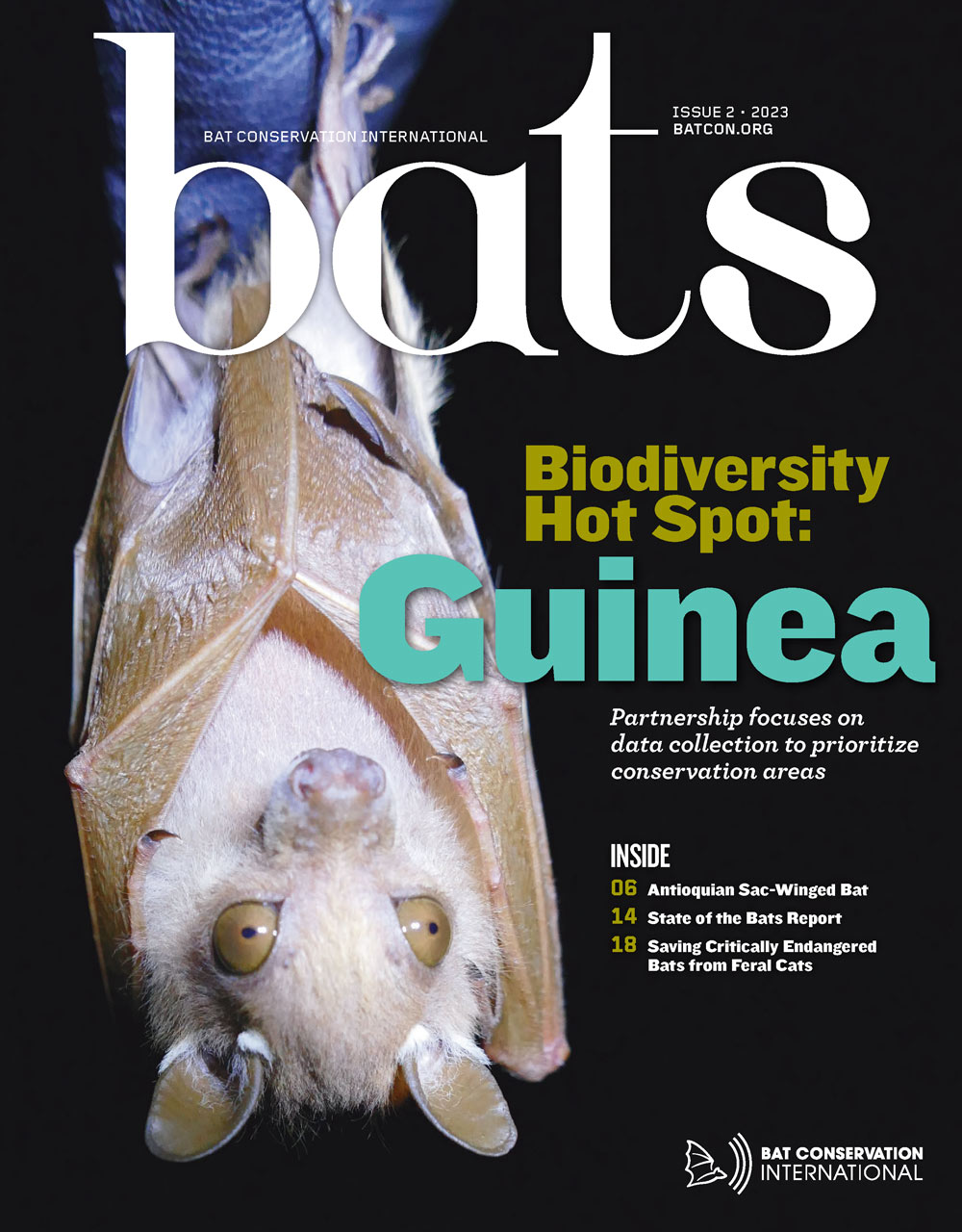
Credit: Natalie Weber


The State of the Bats
The report, published by Bat Conservation International (BCI) and our partners in the North American Bat Conservation Alliance (NABCA), defines in stark terms the perils bats now face. The study found 98% of bat species are losing habitat and 82% face risks from climate change. Bats are facing these devastating global threats while also facing one of the worst wildlife diseases in a century. White-nose Syndrome has killed nine out of every ten little brown bats, northern long-eared bats, and tricolored bats, and the destruction continues.
That’s why BCI, our partners, and our supporters are springing into action. BCI is implementing the most wide-ranging field solutions ever tested to save bats from white-nose syndrome, utilizing cutting-edge approaches like artificial prey patches and customized microclimates in caves and mines to help bats survive.
Masthead

500 North Capital of Texas Highway, Building 1
Austin, TX 78746
512.327.9721
Kristen Pope
Javier Folgar
Michelle Donahue / Proofreader
Publication Management GLC, part of SPM Group
Bats Magazine welcomes queries from writers. Send your article proposal in a brief outline form and a description of any photos, charts, or other graphics to the Editor at pubs@batcon.org.
Members: We welcome your feedback. Please send letters to the Editor to pubs@batcon.org. Changes of address may be sent to members@batcon.org or to BCI at our Austin, Texas, address above. Please allow four weeks for the change of address to take effect.
Chair
Dr. Andrew Sansom,
Vice Chair
Don Kendall, Treasurer
Eileen Arbues, Secretary
Dr. Gerald Carter
Gary Dreyzin
Dr. Brock Fenton
Timo Hixon
Maria Mathis
Dr. Shahroukh Mistry
Sandy Read
Dr. Nancy Simmons
Jenn Stephens
Roger Still
Dr. Enrico Bernard
Dr. Sara Bumrungsri
Dr. Gerald Carter
Dr. Liliana Dávalos
Dr. Brock Fenton
Dr. Tigga Kingston
Dr. Stuart Parsons
Dr. Paul Racey
Dr. Danilo Russo
Dr. Nancy Simmons
Dr. Paul Webala
Mike Daulton, Executive Director
Mylea Bayless, Chief of Strategic Partnerships
Dr. Winifred Frick, Chief Scientist
Michael Nakamoto, Chief Operations Officer
Kevin Pierson, Chief of Conservation and Global Strategy
Visit BCI’s website at batcon.org and the following social media sites:


Bracken Cave Sets World Record
Bracken Cave is home to more than 15 million Mexican free-tailed bats (Tadarida brasiliensis) during the summer. Each evening, the bats depart the cave to search for food in a swirling “batnado.”
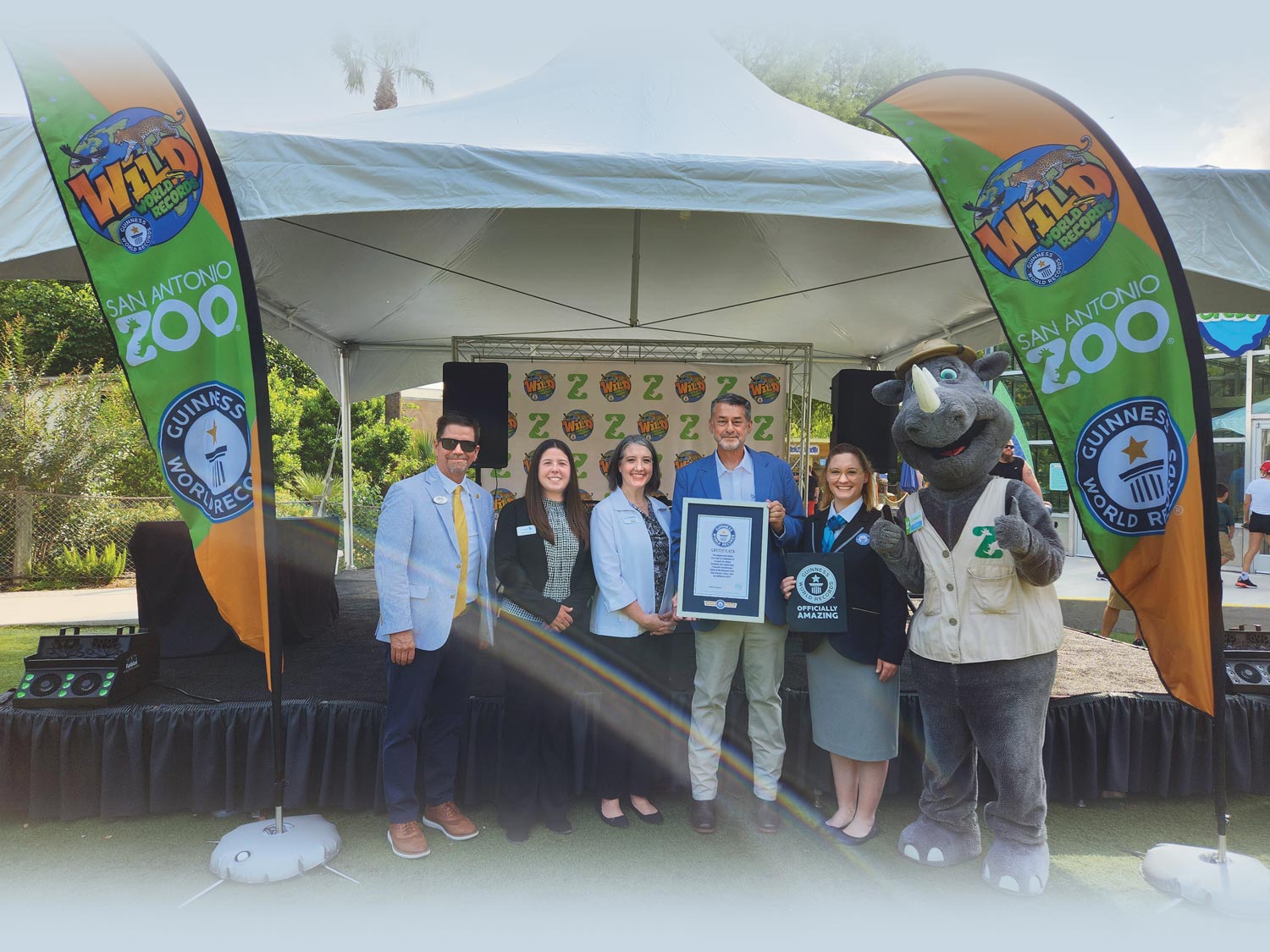
New Pavilion at Bracken Cave
batsignals

Bat Signals

Coming Together to Protect Nivalis
Researchers are working to learn more about the bats’ migration corridor and how they are moving, drinking nectar from agaves and other flowering plants, like columnar cacti, pollinating them along the way. Agaves and other plants used by bats are also used by humans for various purposes. Agaves are used to produce beverages like mezcal and tequila, as well as other products, such as rope, paper, and animal feed. These bats also provide other ecosystem services, like pollinating a variety of crops, including pitaya.
Bat Facts
Learn about the Endangered Florida bonneted bat (Eumops floridanus), with a handy button to listen to the bat’s distinctive call. See the beautiful giant golden-crowned flying fox (Acerodon jubatus), which lives in Southeast Asia, and learn all about its frugivore diet, primarily comprised of figs.
Top up your bat knowledge and immerse yourself in these winged mammals’ worlds by browsing BCI’s revamped bat profile page.

Binomial
Family
Colony size
Weight
Diet
Status

Antioquian Sac-Winged Bat
ast September, while attending the Latin American and Caribbean Bat Congress (COLAM), Dr. Melquisedec Gamba-Rios, Endangered Species Research Fellow at Bat Conservation International (BCI), had something of an epiphany after listening to two presentations.
First, he listened to a talk by Diana Cardona, a Colombian biologist and geographic information systems specialist, about an innovative strategy called habitat banking, in which landowners designate land for conservation in exchange for monetary compensation. Later in the conference, he heard Dr. Sergio Solari, a biology professor at Colombia’s University of Antioquia, speak about the rediscovery of the Endangered Antioquian sac-winged bat (Saccopteryx antioquensis), a species previously thought to be extinct.
Biodiversity Hot Spot: Guinea

hen Natalie Weber saw the truckload of logs scattered across the roadway in southeastern Guinea, she figured her team might be waiting a while. When she saw other stranded travelers build fires and start to cook along the side of the road, she realized they might be in for a long wait, but she took it all in stride. Weber has worked with Guinea’s bats since 2007, and she’s conducted fieldwork in many remote parts of the world, so travel delays are nothing new to her. Her latest foray into the wilds of Guinea was from late January to early March 2023 as a Bat Conservation International (BCI) Research Consultant. Based in Germany, Weber joined a collaborative field team to conduct a bat survey at four sites in the southeastern part of the country. The expedition was wildly successful, recording around 30 different bat species. To put that figure in context, the United States has approximately 50 bat species.
“We’re still waiting for confirmation through genetic results, but it should be a good 30 species that we encountered on the trip,” Weber says.
State of the Bats Report

More than half of all North American bat species face severe risks over the next 15 years
By Lynn Davis
Cross-border collaboration: North
The hoary bat (Lasiurus cinereus) knows no boundaries or borders. Still, it is one of 82 bat species—more than half of the 154 bat species on the North American continent—at risk for severe population declines over the next 15 years, according to the first-ever North American State of the Bats Report.
The report, a monumental tri-national survey generated by the North American Bat Conservation Alliance (NABCA), compiles research from 102 bat experts across Canada, the United States, and Mexico to establish a baseline of data to measure the success of bat conservation and encourage collaboration. Moreover, it presents a united message that bats need help now to avoid catastrophic conditions later.
The hoary bat is one of 154 reasons the report was compiled and a good example of the complex challenges of bat conservation between three countries, according to Dr. Jordie Segers, Canadian National Bat Health Program Coordinator for the Canadian Wildlife Health Cooperative. It’s important to note that some bat species face different challenges in different locations.


Saving Critically Endangered Bats From Feral Cats
“A cave with that many bats and species is always going to be worthy of our attention,” says Dr. Jon Flanders, Bat Conservation International’s (BCI) Director of Endangered Species Interventions, who calls the mega-roost site “a paradise for bats.” The impressive breeding ground is the last frontier for the Critically Endangered Jamaican greater funnel-eared bat (Natalus jamaicensis), whose population has dwindled to roughly 250 individuals.

Tragedy and Triumph in Comoros

For weeks at a time, Dr. Mandl, Bat Conservation International (BCI) Endangered Species Interventions Research Fellow, heads to Comoros to tag the Critically Endangered Livingstone’s fruit bat (Pteropus livingstonii) with GPS trackers. Because little is known about the habits of these bats, which have a maximum wingspan of four feet, the tracking data provides crucial information about their day-to-day lives.

Eavesdropping on Endangered bats
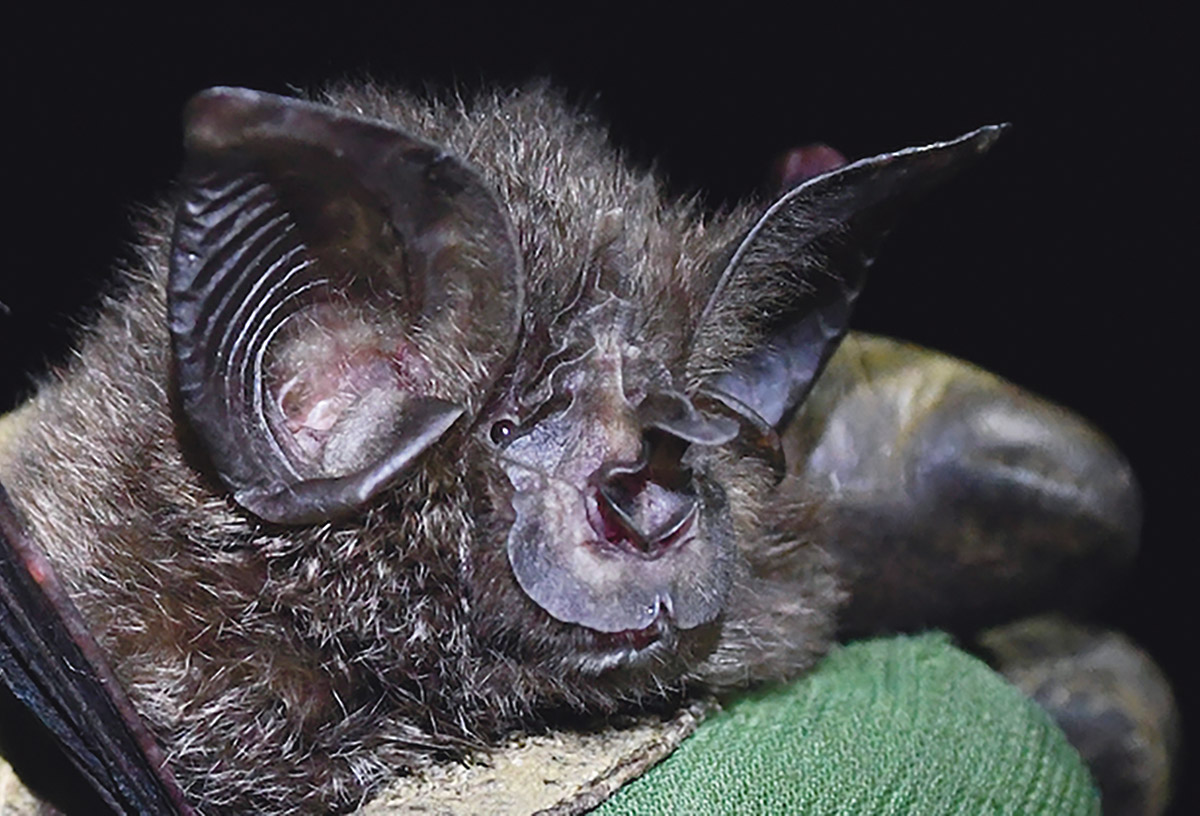
In partnership with the Rwanda Wildlife Conservation Association, the Rwanda Development Board, Nyungwe Management Company, and African Parks, BCI supports acoustic monitoring by park rangers to identify important roosting and foraging sites. As bats move through their habitat, they use echolocation for spatial orientation and to find food, emitting unique calls at high frequencies beyond the range of human hearing. Nyungwe rangers use special recorders, or “bat detectors,” to capture this acoustic data and lower the sounds to levels human ears can hear. From there, they can match calls with GPS data identifying where they were recorded.
fieldnotes

Intrepid Bat Explorer
r. Adrià López Baucells is a bat ecologist and conservationist who has traveled the world studying and photographing bats. The National Geographic Explorer is now a postdoctoral researcher at the Natural Science Museum of Granollers in Catalonia, Spain. Dr. Baucells started his career working with bats at the museum in 2005 while earning his bachelor’s degree.
As he continued his studies, he worked in Colombia studying neotropical bats, and in Australia researching flying foxes. Then he spent three years in Brazil collecting data for his doctorate on bats’ habitat loss and forest fragmentation.

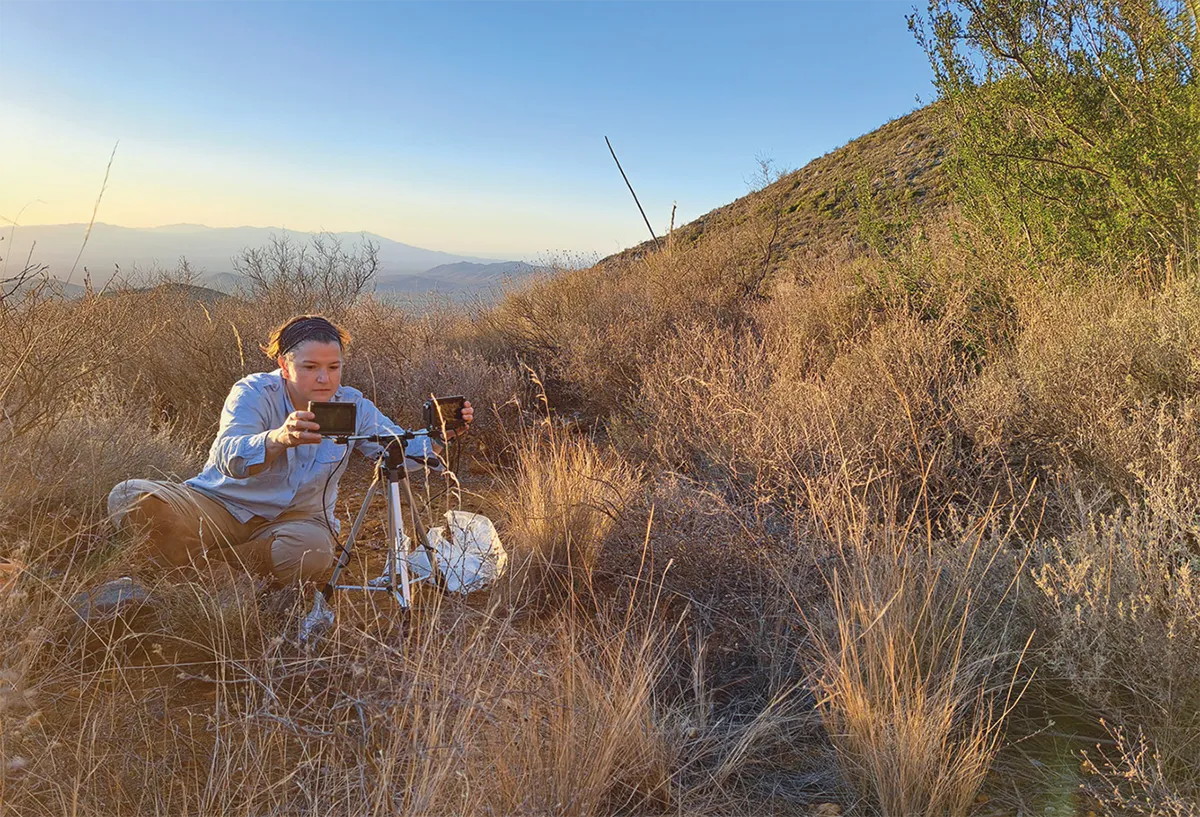
Bat Chat with Dr. Ana Ibarra
lanting agaves in strategic locations throughout the arid landscape between Central Mexico and the U.S. Southwest is one way to sustain diminishing numbers of Mexican long-nosed bats (Leptonycteris nivalis) and assure the survival of desert ecosystems, according to Dr. Ana Ibarra, Bat Conservation International’s Strategic Advisor for Endangered Species in Mexico and Latin America. Dr. Ibarra is one of nearly a dozen people interviewed and profiled in a series of videos and short online features that illustrate what is being done to save Endangered Mexican long-nosed bats and diminishing numbers of agaves.
What is the connection between Mexican long-nosed bats and agaves?

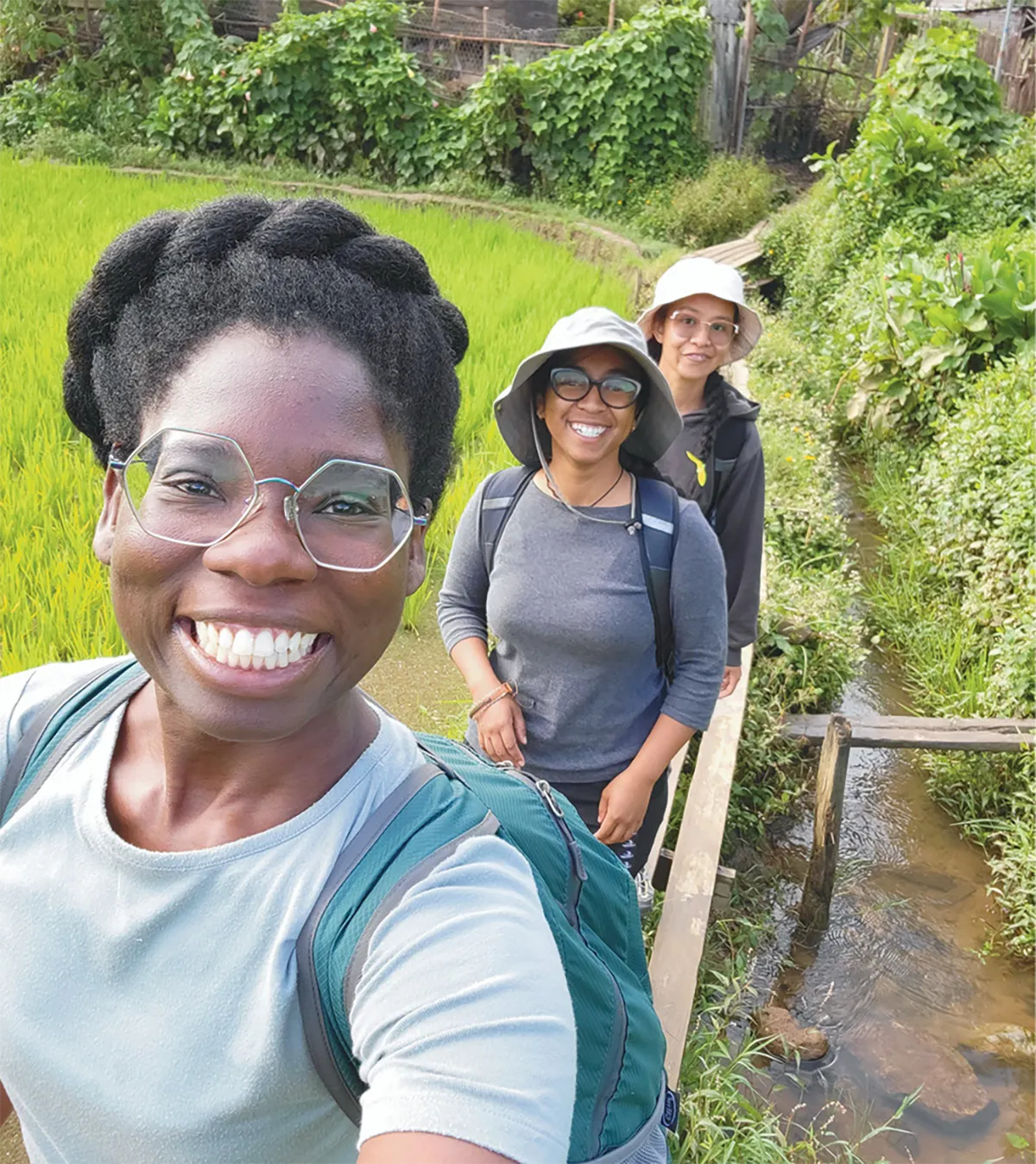
Sharing Space with Bats
n Madagascar, people share many buildings with bats, and Bat Conservation International (BCI) Student Scholar Anecia Gentles is working on learning more about how these shared spaces impact human health. Gentles is a doctoral student at the University of Georgia, working with field assistants Stèphie Raveloson and Sidonie Rakotoarisoa on a project studying insectivorous bats in eastern Madagascar. They are studying how the physical characteristics of buildings might relate to the presence of bats roosting inside and how that may translate to the risk of pathogens spreading to humans. They are also learning how humans feel about bats and sharing space.
“We are most interested in whether or not there are any health consequences for people who have to share their space with these really large bat colonies,” Gentles says. “Some of these buildings have had bats for as long as people have worked in these buildings. A lot of the schools are anywhere from 50-100 years old, and no one knows of a time when there were no bats in the buildings, so the guano buildup is quite a bit, and you can smell it from far away.”
